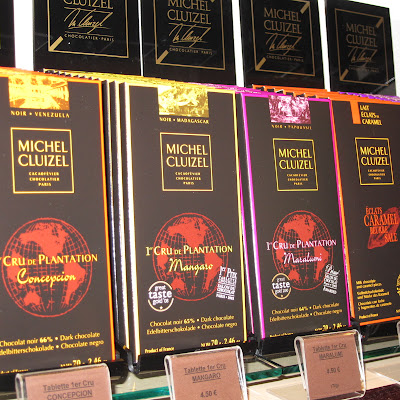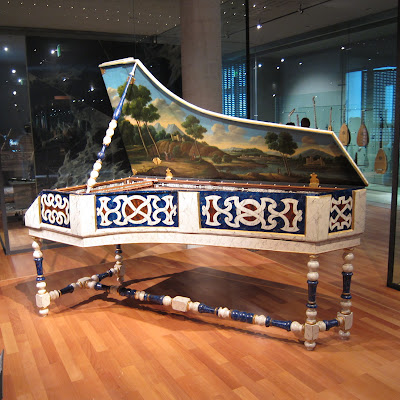I think we have a problem. Seriously. Is there such a thing as "Chocoholics Anonymous?" We are definitely going to need a support group when we get back home -- the chocolates here in Paris are simply the best anywhere. And maybe the most expensive too!
Paris is called the dark chocolate capital of the world, giving us just one more reason why she is the greatest city on the planet. Paris has about 300 chocolate shops -- we could not visit them all, but we did our best!
To begin our chocolate explorations, we signed up with our favorite tour group, "Paris Walks", for their Chocolate Walk. Our guide, Brigitte, talked about the history of chocolate as she led us from one big name chocolatier to another: Gosseln, Michel Cluizel, Cote de France, and Jean-Paul Hévin. With tastings at each one. Mon dieu!
Brigitte taught us the secret of knowing good chocolate when you're eating it. She said that just a little bit of good chocolate will satisfy - that's how you know it's gooooooood choco. If your taste buds demand more and more of that choco bar you are eating, then it's NOT good chocolate. And here's why: you are not getting that vital "fennel-ethylamine" hit that good choco always has in abundance, and that satisfies the palate in small doses.
So, bottom line, if you down that whole chocolate bar that you've been chomping on, and still crave more, you were NOT eating the good stuff!! Just a small piece of good choco will sate the palate.
Cocoa beans grow on trees in a fairly limited part of the world, within a narrow band that lies 15 to 20 degrees north and south of the equator. Cocoa beans love the shelter of the rain forest and thrive in the high humidity and constant temperature.
We have come to realize that chocolate is NOT just for kids. This is a complex food that needs to be studied (and tasted, of course) much like a fine wine. The beans come in three varieties: 1) Criollo, originally cultivated by the Mayans, is the very best quality chocolate and is now grown in Mexico, South and Central America, and Indonesia. 2) Forastero, grown in Brazil and West Africa, represents 90% of all beans, and 3) Trinitario, which is a cross between the first two and is unique to Trinidad.
 |
| Cocoa Trees with bean pods |
And, if you wish to fine-tune the selection of good choco even more, there is a Criollo chocolate bean called "Porcelana"; this is a white-ish bean that got its name because it looks like porcelain. It is grown around Lake Maracaibo in Venezuela, and has a limited amount of harvesting each year - only a few thousand pounds are made into choco. In the chocolate community, it is touted as one of the best tasting chocos, and it is one of the rarest too.
The porcelana bean is a tiny subset of the Criollo family, and is considered to be the most genetically pure. Naturally, we sought out the porcelana for a try, and we found some. Yesssssss!
 |
| Porcelana Chocolate Bars |
Fine chocolate in Paris costs about 95 to 150 euros per kilo. In the English system of money, that's about $35 - $60 per pound. But, this is just the beginning. Depending on the intricacies of making the chocolate, the price can go much higher. It has a cachet similar to gold, and, as a matter of fact, in days of yore, it was used as money by the denizens of countries where chocolate beans were harvested. Ten choco beans could buy a whole dead rabbit (for dinner); 3 choco beans could buy a single turkey egg; and 1 bean could buy 5 green peppers, or one large tomato, etc, etc.
But let's move on to some actual tasting. If you look closely at the chocolates shown below (these babies are called "Operas"), you will see the flecks of honest-to-God edible gold leaf on the top-center of each brownie-sized chocolate. Yes, we ate gold on this tour; granted, it wasn't much gold, but real gold nonetheless! Only the best for us choco lovers in Paris!
 |
| Chocolate with "edible gold" chips on top |
We won't tantalize you by recounting every delectable chocolate morsel that we ingested, so our account here will only address some of the more interesting.
This coin-shaped wafer about the size of a silver dollar is made of 99% pure cacao (cacao is just an earlier version of our word cocoa -- you say cocoa; I say cacao). This wafer is called a "Pistole" by the French. We thought these pistoles might be overly bitter given the high density of cacao, but they were actually not too bad at all - an acquired taste, like wine.
 |
| "Pistoles" (99% pure chocolate) |
And, by the way, chocolate this dark and pure is really very healthy; it is loaded with disease-fighting anti-oxidants needed to maintain a healthy body. (We doubt you are fooled by our attempt to pass off our chocolate binge as medicinal, but we thought we'd give it a shot! It certainly helps us justify our sinful behavior.) One historical note here: pistoles were the favorite candy of Marie-Antoinette. She was somewhat of a "pistole addict" and had a continued supply delivered to her palace.
We learned that Parisian chocolates come in very specific styles -- like these dark choco "mendiants" topped with many different types of nuts (hazelnuts, pistachios, walnuts, almonds, and the like):
 |
| Dark Chocolate Mendiants |
Or these chunks of nut-filled chocolate bars called "tablettes" in both the milk chocolate and the dark chocolate varieties. The chocolatier simply breaks pieces of these tablettes into manageable sizes, weighs them, and charges you accordingly:
 |
| Nutty delights in both light and dark chocolate versions |
You might think that one chocolate walk would be enough, but our "Paris Walks" tour only inspired us to put together our own do-it-yourself Chocolate Walk a few days later (after our blood sugar had normalized from the 1st tour).
We ventured out onto our "very own" self-designed Paris Chocolate Walk, in search of the most perfect chocolates, tailored specifically for the "Supsic Palates". We began at our #1 most favorite chocolatier (from our previous walk): Jean-Paul Hévin. Jean-Paul's chocolates really are just like his last name implies - "Hévin-ly", and although Anne has never even seen the man, she has developed a secret crush.
Jean-Paul has a sweet little tea room above his shop that was the perfect spot to fortify ourselves with a light lunch before making our second assault on his choco shop, and then, the other 299 chocolate shops around Paris. And Jean-Paul just happens to serve a totally decadent hot chocolate with real (sweet & creamy) whipped cream. Believe me, this is not Ovaltine!
So, in case any of you happen to be in Paris, eating brunch in Jean-Paul's tea room over there at 231 Rue Saint-Honoré, you need to order the scrumptious Chaud Chocolat Viennoise seen here to top off your meal:
 |
| Having a rich Hot Chocolate drink at Jean-Paul Hévin's Tea Shop |
We left Jean-Paul's tea room, and after perusing his choco shop at length, we made our way from choco-shop to choco-shop, visiting several more of the big names in the chocolate industry, like Debauve & Gallais, the oldest choco-shop in Paris (Marie-Antoinette bought her pistoles here).
And then there is Patrick Roger (pronounced: "ROW-ZHEY") who is considered a "chocolate artist," importing ingredients like oranges from Corsica and cocoa beans from places like Vanuatu, Venezuela, and Ecuador. Patrick Roger's choco is probably the most expensive in the world (certainly the most expensive in Paris) mostly because only the finest ingredients are dared to be used, and all of his chocos are handmade from scratch. Notice his signature turquoise blue packaging (reminds us of shopping at Tiffanys).
We hope by now you will understand when we tell you that we had trouble fitting our newly acquired chocolate stash into our suitcases (see the goods below). But we did it, and now we will have a little bit of Paris to nibble on back in Saylorsburg!


















































